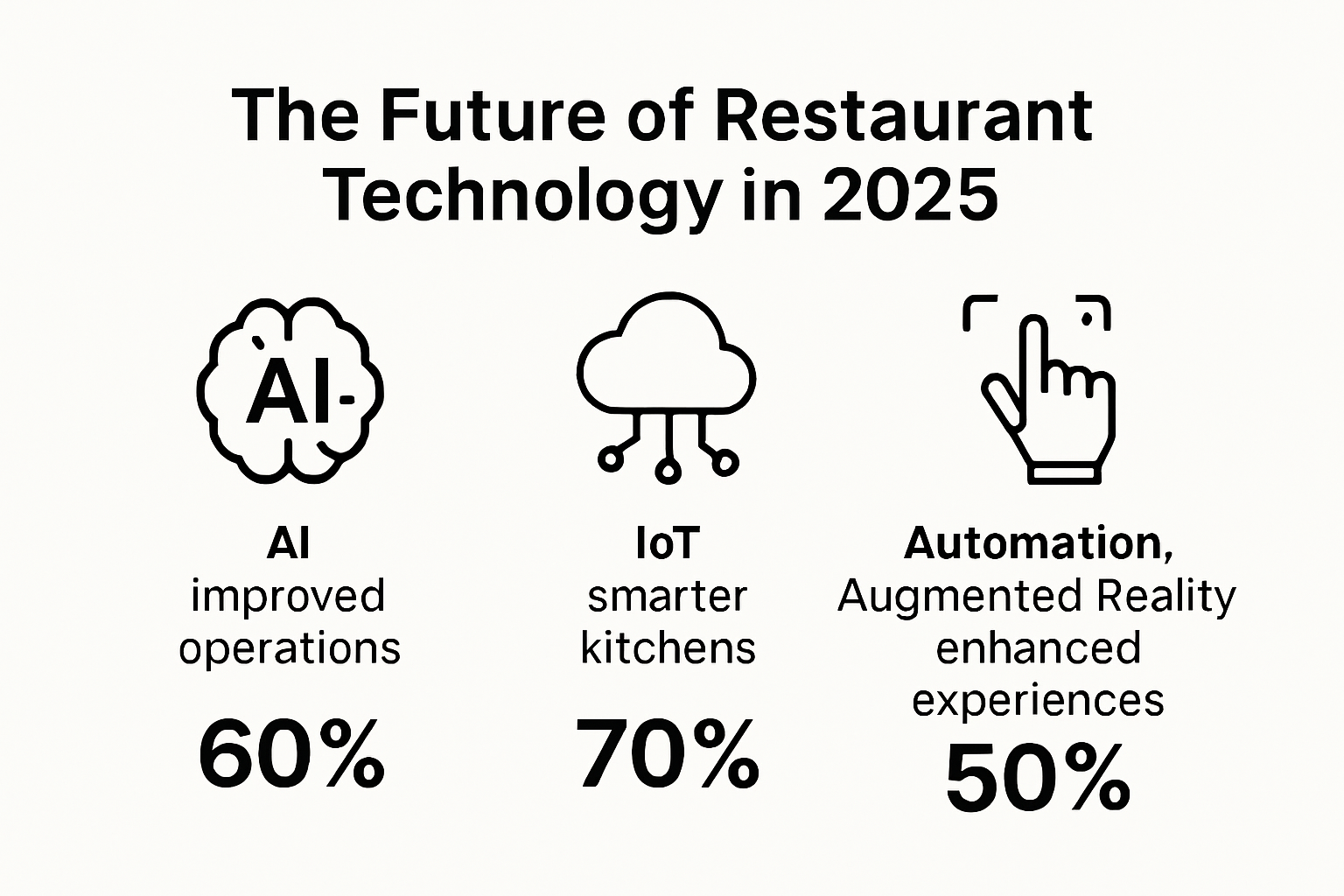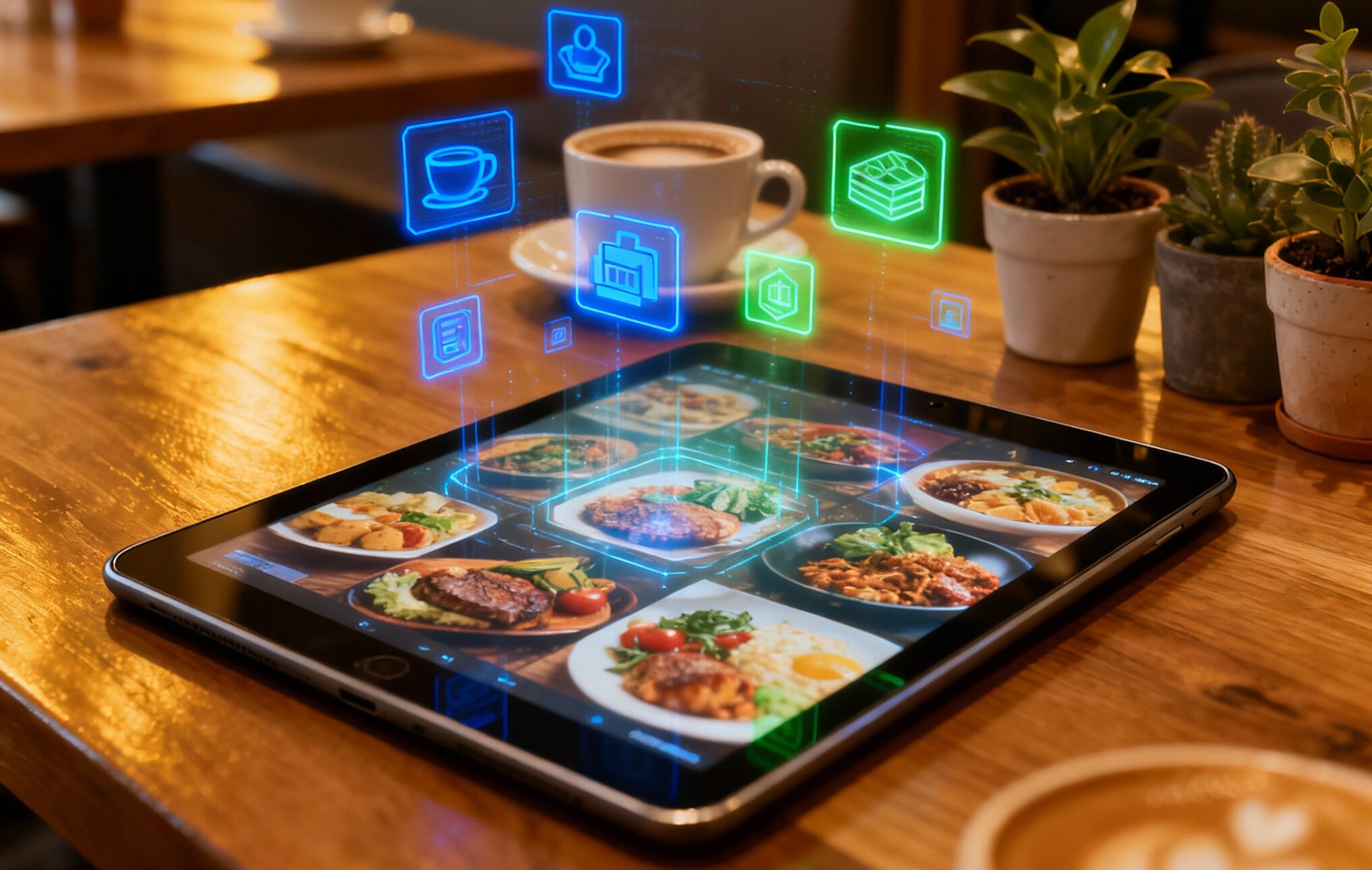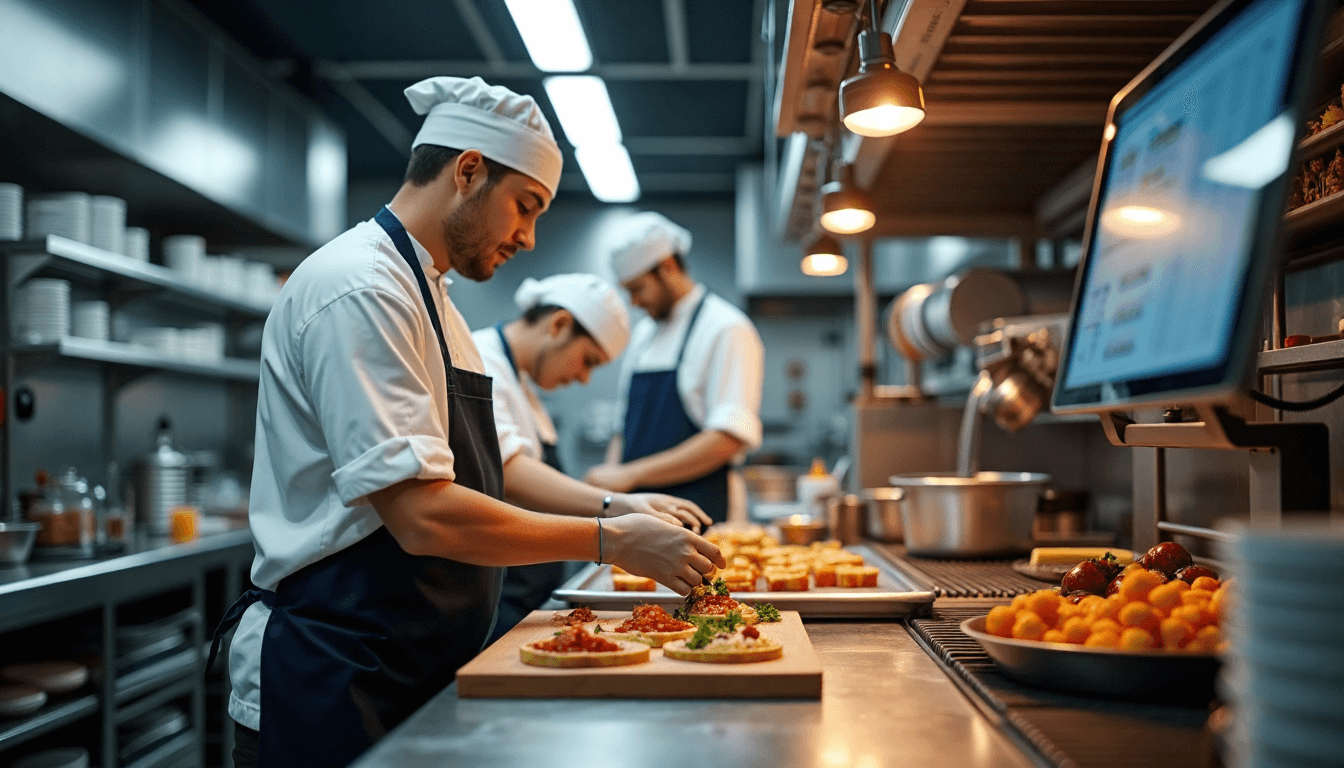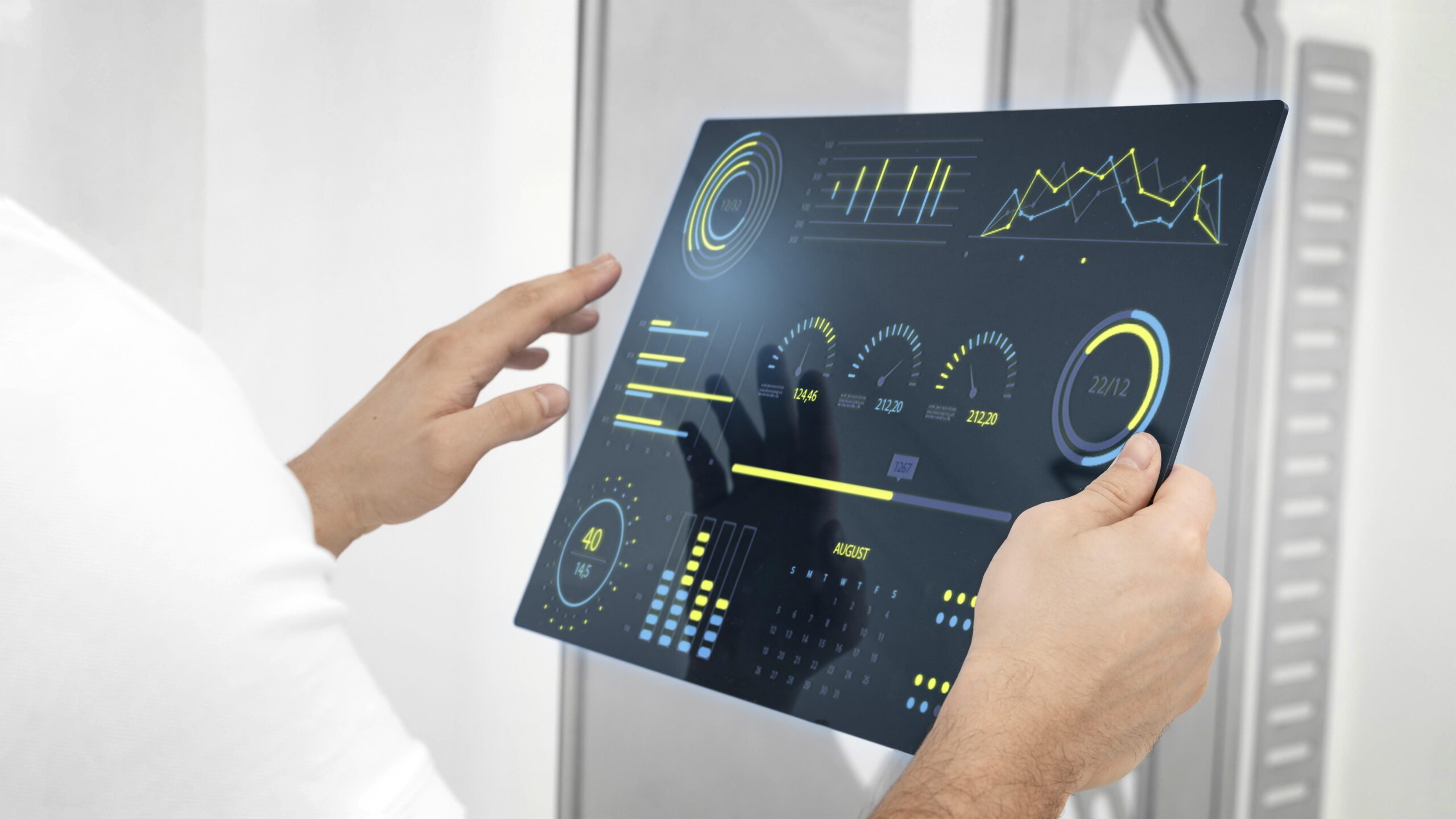Restaurant tech is growing at a dizzying pace and will look very different by 2025. Here is a shocker. Restaurants using automation have seen labour costs drop by 15 percent and monthly sales rise 20 percent. Yet it is not the robots or flashy screens stealing the show. The real leap comes from smart systems quietly reshaping kitchens and customer experiences in ways most diners never notice.
Quick summary
Takeaway | Explanation |
|---|---|
Embrace artificial intelligence | Restaurants should leverage AI to personalise customer experiences and predict dining trends, which enhances satisfaction and engagement. |
Adopt IoT for kitchen management | Implement IoT devices to monitor equipment, track inventory, and optimise energy use, leading to a more efficient and cost-effective kitchen. |
Implement automation | Utilise automation in kitchen operations and order management to reduce labour costs and improve operational efficiency. |
Invest in augmented reality | Augmented reality can provide immersive experiences for diners, such as visualising menu items and exploring ingredient information, thus enhancing customer interaction. |
Focus on comprehensive staff training | Prioritise tailored training for staff on new technologies to ensure successful implementation and maximise their impact on operations and customer service. |
Emerging technology shaping restaurants in 2025
The restaurant industry stands on the brink of a technological revolution that promises to redefine how establishments operate, engage customers, and deliver dining experiences. By 2025, emerging technologies will transform every aspect of restaurant management, from kitchen operations to customer interactions.

Artificial intelligence transforms customer experience
Artificial intelligence is rapidly becoming the cornerstone of innovative restaurant technology. Research on restaurant technology innovations reveals that AI systems are moving far beyond simple recommendation engines. Modern AI platforms can now predict customer preferences with remarkable accuracy, personalise menu suggestions in real time, and even anticipate dining trends before they emerge.
According to a comprehensive study by Flipdish, AI-driven systems are enabling restaurants to create highly tailored experiences. These intelligent platforms analyse customer data points such as previous orders, dining times, and dietary preferences to generate personalised recommendations that significantly enhance customer satisfaction.
Internet of things revolutionising kitchen management
The Internet of Things (IoT) is transforming restaurant kitchens into smart, interconnected environments.
Research from SGC Food Service demonstrates that IoT devices are now capable of monitoring kitchen equipment performance, tracking inventory levels with unprecedented precision, and optimising energy consumption.
Key IoT applications in restaurant technology include:
Smart refrigeration: Sensors that monitor temperature and food freshness in real time
Automated inventory tracking: Systems that automatically reorder ingredients when stock levels drop
Energy management: Connected devices that optimise equipment usage and reduce operational costs

Augmented reality enhances dining experiences
Augmented reality is emerging as a groundbreaking technology that will fundamentally change how restaurants interact with customers. Advanced research published in academic journals reveals that AR can create immersive dining experiences by allowing customers to visualise menu items, explore virtual table settings, and even interact with digital restaurant environments.
Restaurants are beginning to experiment with AR technologies that enable customers to:
Preview dishes before ordering
Explore detailed ingredient information
Engage with interactive menu experiences
These technological advancements represent more than just incremental improvements. They signal a fundamental transformation in how restaurants operate, communicate with customers, and deliver value. As we move towards 2025, restaurants that embrace these emerging technologies will gain significant competitive advantages, creating more personalised, efficient, and engaging dining experiences.
The future of restaurant technology is not just about adopting new tools it is about reimagining the entire dining ecosystem through intelligent, interconnected solutions that prioritise customer experience and operational efficiency.
How automation improves restaurant operations
Automation is revolutionising restaurant operations, transforming traditional workflows into highly efficient, data-driven processes that dramatically reduce manual labour and increase productivity. By 2025, restaurants will increasingly rely on sophisticated automated systems to streamline every aspect of their business.
Kitchen automation and efficiency
Modern kitchen technologies are redefining operational efficiency. Restaurant automation tools demonstrate remarkable potential in reducing human error and optimising food preparation processes. According to research from the Brookings Institution, automation technologies can significantly reduce production costs while conserving critical resources like water and energy.
Advanced robotic systems are now capable of performing precision tasks such as:
Consistent food preparation: Robots that can chop, mix, and cook with unparalleled accuracy
Temperature monitoring: Automated systems tracking food safety and cooking temperatures
Ingredient portioning: Precise measurement and allocation of ingredients

Order management and customer service automation
A comprehensive study published in the Futurity of Social Sciences revealed compelling statistics about restaurant automation. Establishments implementing automated systems experienced substantial improvements: a 15% decrease in labour costs, a 20% increase in monthly sales, and a 10% improvement in customer satisfaction.
Automation technologies are transforming order management through:
Digital ordering platforms: Seamless integration between customer interfaces and kitchen systems
Automated reservation management: Real-time booking and table allocation
Intelligent customer communication: AI-powered messaging and reservation confirmations

Data-Driven operational Insights
Research from the Worldwide Hospitality and Tourism Themes journal highlights how artificial intelligence and smart technologies are generating unprecedented operational insights. Automated systems now collect and analyse complex data streams, enabling restaurants to make more informed decisions about staffing, inventory, and customer preferences.
Key benefits of data-driven automation include:
Predictive inventory management: Anticipating ingredient requirements
Dynamic pricing strategies: Adjusting menu prices based on real-time demand
Staff performance tracking: Identifying training needs and operational bottlenecks
As restaurants embrace these technological advancements, automation becomes more than a convenience it represents a fundamental reimagining of operational strategy. By 2025, successful restaurants will be those that strategically integrate automated systems, transforming traditional operational models into intelligent, responsive, and highly efficient enterprises.
The future of restaurant operations is not about replacing human workers but empowering them with tools that enhance productivity, accuracy, and overall business performance.
Here is a summary table outlining the key impacts of automation on restaurant operations, based on statistics and features discussed in this section:
Area of impact | Benefit | Example/Data |
|---|---|---|
Labour costs | 15% decrease | Automated systems reduce required staffing |
Sales | 20% increase | Increased efficiency leads to higher throughput |
Customer satisfaction | 10% improvement | Faster service, fewer errors |
Production costs | Cost reduction | Through robotic food prep and efficiency |
Resource conservation | Water and energy savings | Automated equipment management |
Food safety & accuracy | Improved monitoring and consistency | Precision temp control, robotic portioning |
Strengthening customer experience with smart solutions
As technology continues to evolve, restaurants are discovering innovative ways to transform customer experiences beyond traditional service models. Smart solutions are becoming pivotal in creating personalised, engaging, and seamless dining interactions that meet the increasingly sophisticated expectations of modern diners.
Personalised dining recommendations
Artificial intelligence is revolutionising how restaurants understand and cater to individual customer preferences. Our guide on customer engagement highlights the emerging trend of hyper-personalised dining experiences. According to the National Restaurant Association’s 2024 survey, 16% of restaurant operators are actively investing in AI technologies that can handle customer inquiries and provide tailored food recommendations.
These intelligent systems analyse multiple data points including:
Previous dining history: Understanding individual taste preferences
Dietary restrictions: Automatically suggesting compatible menu items
Seasonal preferences: Adapting recommendations based on time of year
Augmented reality enhanced interactions
Advanced research published in academic journals reveals that augmented reality is transforming customer interactions. By creating immersive digital experiences, restaurants can now offer customers unprecedented levels of engagement and information about their dining environment.
AR technologies are enabling customers to:
Visualise menu items: Seeing detailed 3D representations of dishes
Explore ingredient origins: Understanding food sourcing and preparation
Interactive table experiences: Customising dining atmosphere through digital overlays
Intelligent communication platforms
Modern customer service is moving beyond traditional communication channels. Smart communication platforms are integrating AI-powered messaging, real-time support, and predictive customer service approaches. These systems can:
Provide instant reservations: Seamless booking experiences
Send personalised reminders: Reducing no-show rates
Offer tailored promotional content: Based on individual customer profiles
By embracing these smart solutions, restaurants are not just improving operational efficiency they are fundamentally reimagining customer relationships. The future of dining is about creating memorable, personalised experiences that go far beyond simply serving food.
Restaurants that successfully integrate these technologies will differentiate themselves in an increasingly competitive market, transforming casual dining into an interactive, technology-enhanced journey that delights and surprises customers at every touchpoint.
The following summary table compares key smart solutions for enhancing customer experience, showcasing their main functions and benefits:
Smart solution | Main function | Customer benefit |
|---|---|---|
Personalised dining recommendations | Tailor menu suggestions via AI | More relevant, satisfying meal choices |
Augmented reality interactions | Immersive, visual menu & environment | Enhanced engagement, better understanding |
Intelligent communication platforms | AI-powered messaging & reminders | Seamless bookings, personalised offers |
Best practices for adopting new technologies
Successful technology adoption in restaurants requires more than simply purchasing cutting-edge tools. It demands a strategic, comprehensive approach that considers organisational culture, staff capabilities, and long-term business objectives. Restaurants must navigate technological transformations with careful planning and intentional implementation.
Strategic technology assessment
Research from Modern Restaurant Management emphasises the critical importance of thorough technology evaluation before implementation. Restaurants should conduct comprehensive assessments that examine not just immediate functional requirements, but also long-term scalability, integration capabilities, and potential return on investment.
Key considerations during technology assessment include:
Compatibility with existing Systems: Ensuring new technologies seamlessly integrate with current infrastructure
Scalability potential: Selecting solutions that can grow alongside the business
Cost-benefit analysis: Evaluating both immediate and projected financial implications
Comprehensive staff training and engagement
A strategic study on digital transformation highlights that successful technology adoption hinges on employee involvement and education. Our comprehensive guide to technology integration recommends creating tailored training programmes that address different staff roles and learning styles.
Effective training strategies encompass:
Role-Specific training modules: Customised learning paths for different staff positions
Hands-On practice sessions: Practical workshops that build confidence
Continuous learning resources: Ongoing support and skill development opportunities
Phased implementation and continuous evaluation
Hospitality technology experts recommend a measured approach to technology rollout. Pilot programmes allow restaurants to test new technologies in controlled environments, gathering critical feedback and making necessary adjustments before full-scale implementation.
A robust implementation strategy should include:
Pilot testing: Controlled trials in specific restaurant sections
Feedback mechanisms: Structured channels for staff and customer input
Performance monitoring: Regular assessment of technological effectiveness
Successful technology adoption is not about chasing the latest trends, but strategically selecting and implementing solutions that genuinely enhance operational efficiency, customer experience, and business performance. Restaurants must view technological investments as ongoing journeys of adaptation and improvement.
By approaching new technologies with thoughtful planning, comprehensive training, and a commitment to continuous learning, restaurants can transform potential disruptions into opportunities for innovation and growth. The goal is not just to implement technology, but to create a dynamic, adaptive technological ecosystem that evolves with the changing demands of the hospitality industry.
Frequently asked questions
Restaurants are expected to embrace artificial intelligence for personalised customer experiences, utilise the Internet of Things for kitchen management, implement automation to improve operations, and adopt augmented reality to enhance dining experiences by 2025.
Artificial intelligence can analyse customer data to provide personalised menu suggestions, predict dining trends, and enhance overall customer satisfaction by tailoring experiences to individual preferences.
Automation reduces labour costs by approximately 15%, increases monthly sales by about 20%, and improves operational efficiency through streamlined processes in kitchen management and order systems.
Successful adoption involves strategic technology assessment, comprehensive staff training, and phased implementation. Pilot testing new technologies helps gather feedback and make necessary adjustments before full-scale rollout.
The future of your restaurant relies on making smart choices today. As highlighted in our article, automation, AI, and data-driven solutions are key trends for 2025. Yet, so many venues still struggle with missed bookings, inefficient table management, and customer expectations that keep rising. If you are feeling the pressure of daily manual workflows or worrying about increasing no-shows, there has never been a better time to transform your business.
Ready to take bookings seriously?
Try Tableo’s free version for up to 100 covers monthly– no credit card, no fuss.
Free Version – Free Setup – Free Training – Free Support


Stephanie Paris
Gen-Z marketing coordinator bringing fresh energy to web and graphic design, with a weekend habit of chasing adventure.
-
Previous Post
Best Apps to Find Restaurants Near You (Besides Google)









